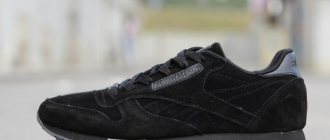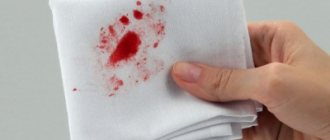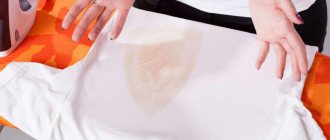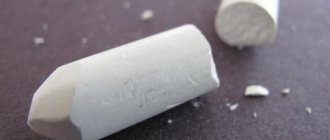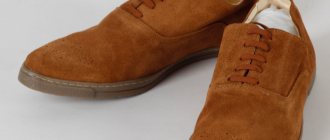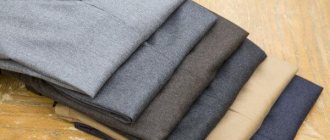How to easily remove grease stains from a leather bag
Leather is great for making accessories and shoes. Such products are durable, look great for a long time, but also require appropriate care. But even a careful attitude sometimes does not prevent the appearance of dirt; various marks appear on objects.
Few people know how easy it is to remove a greasy stain from a leather bag; most people immediately go to a dry cleaner, where specialists will be able to remove the stain without any problems. What to do if there is neither money nor time for a special institution? How to remove stains from leather shoes and bags yourself?
Tips and tricks for preparation
Before removing a greasy stain from leather shoes or an accessory, you need to prepare the product for the procedure. To do this, carry out a number of simple manipulations with the contaminated item:
- First remove dirt and dust using a damp cloth.
- Heavily adhered pieces of dirt or other substances should not be scraped off, otherwise the likelihood of damage to the item of clothing increases.
- The shoes are dried well, the bag is also placed in a well-ventilated area, without additional heating. Direct sunlight should also be avoided.
After this, you can start troubleshooting the problems, but first you should know some processing prohibitions:
- Before using any of the selected products to remove marks from leather products, a test is carried out. Apply a small amount of product to an invisible area and leave for 7-10 minutes. If the place has not been deformed or changed color, then its further use is permitted.
- The preparatory process with cleaning is mandatory; without it, applying special substances to problem areas is not recommended.
- After preliminary cleansing, it is important to let the product dry; wet skin will react with the substance, the results of which may not be predictable.
Only after this you need to get to work. We will find out in more detail how to remove stains of this origin.
Why do white spots appear on shoes?
Before you get rid of white stains on shoes, you should find out what caused them. The reason may not only be the salt and other reagents used to treat roads.
- mold : fungal deposits appear due to improper storage of shoes. For example, in unventilated and damp places. To remove white mold residue, wipe your shoes with cologne, ammonia, or any other product containing alcohol. To avoid future mold stains, dry your shoes thoroughly, stuff them with paper to maintain their shape, and store them in ventilated areas;
At first glance, these appear to be salt stains. Look closely - mold
- limescale : a white coating caused by the reaction of the shoe material to an unsuitable care product, such as a water-repellent treatment. Wipe your boots with alcohol and change the product;
- excessive impregnation of shoes with oil or wax . If white spots appear after treatment with cream or wax, dry the boots with a hairdryer and carefully remove the layer of product using a dry cloth. Wipe your boots with alcohol.
If it's all about salt, you can use special shoe cleaning products or improvised means.
Use a special suede brush. It has a rigid structure
Milk and soda
To do this, pre-prepare a solution:
- A glass of milk is boiled.
- Add a teaspoon of soda.
- Stir and allow to cool completely.
Using a soft cloth soaked in the solution, apply the substance to problem areas and rub in. It is advisable to repeat the procedure several times to achieve excellent results.
How to remove white plaque from leather shoes
Compared to suede, leather is less susceptible to moisture, which increases cleaning capabilities. First, remove any remaining salt using wet and dry cloths. Pay special attention to joints and seams where salt may become clogged.
A set for all occasions
Then use the products you have at hand to remove any remaining white stains on your leather shoes:
- Home cleaning classic: a solution of vinegar and water, mixed 1 to 3 . Use only 6-9% vinegar. Then soak a cloth in vinegar and go over the stains that appear on the skin. When the streaks disappear, wipe the shoes with a dry cloth and wait 30 minutes. Rub your boots with cream or wax and polish them.
- Sour : a mixture of vinegar, water and lemon juice. A similar remedy, except for one ingredient - lemon juice. It will enhance the reaction when removing plaque.
- Fat mixture: vegetable oil or castor oil . Wipe stains with a clean cloth soaked in warm water. Use a dry cloth to remove moisture. Then apply a drop of castor or vegetable oil to a cotton pad and apply it to your skin. Wait 3-4 hours. If streaks remain, repeat the procedure.
- Just not inside yourself : alcohol solution. Rub the skin along the streak lines until the stains disappear. Leave the shoes to dry.
- Straight from the medicine cabinet: fish oil and castor oil . Mix fat and castor oil in a ratio of 3 to 1, place the resulting liquid in a water bath and heat for 1-3 minutes. Apply the warm solution to your shoes and wait a few hours.
- For those who don't mind : a piece of bacon. Rub the skin with lard and leave them for half an hour. Wipe thoroughly with a dry cloth until shiny.
If all else fails, you can use a special paint or cream to treat the leather.
The cream will cope even with old stains
Important: the available products listed above will help remove white spots on shoes made from both leather and substitutes.
To combat old salt stains that you haven't cleaned in days, use castor or vegetable oil for a week. This way you can not only get rid of salt deposits, but also improve the appearance of the skin and increase its protective properties.
A little castor oil every evening, and even old shoes will shine. Preventing a problem is easier than solving it.
Turpentine
A cloth of natural fibers and turpentine will become real saviors for genuine leather products. The substance in its pure form is rubbed into problem areas until they disappear completely.
Expert opinionValeria PrikhodkoAn experienced housewife. Ask a question to an expertAdvice! The peel of an orange will tell you how to remove oil from a leather surface. Rub the mark with fresh zest until it is completely eliminated, and no additional treatment is needed for the area.
We figured out how to remove a greasy stain from a leather bag, but what to do with shoes with such problems?
How to remove salt from shoes: handy products for leather and suede
To remove white stains from suede shoes, stuff the inside of the boots with newspaper or cat litter and leave to dry. Then treat the suede with a stiff brush, moving it along and then against the pile.
Important: Before using any products on suede, test them on an inconspicuous area.
If the brush does not help, try removing plaque from suede shoes using improvised means.
To remove remaining stains, make a solution of water, ammonia and laundry soap. Treat the suede, being careful not to get it wet. Alternatives to solution:
- semolina, which must be poured onto the material and left for 3-4 hours;
- potato: cut it and treat salted areas with half;
- a piece of rye bread, which can be used to walk over the material to absorb salt;
- tooth powder, which should be poured onto the dirty area and rubbed with a brush.
Have you forgotten what tooth powder looks like yet?
Then hold the boots over the steam for 2-5 minutes. This will help renew the pile and evaporate the salt from it. As a source of steam, you can use an iron, steam generator, kettle or pan in which castor oil is heated. Make sure that the suede does not get too wet during processing. Don't forget to comb the material to one side after processing.
If this does not help remove white plaque from suede shoes, then there is only one way out - special coloring compounds. This is due to the fact that the reagent managed to saturate the material through and through.
With paint you no longer have to worry about plaque. The main thing is to choose the right color
Tip: when removing stains from nubuck, you can use the above products. Or treat the material with a soap solution (a couple of drops of dishwashing detergent or laundry soap per liter of water).
Natural leather requires special care
Features of working with leather
Before using a particular substance, it is necessary to test its effect on the material on the inside of the shoe. And only after making sure of complete safety, feel free to start cleaning. When working with professional cleaning products purchased in a store, carefully read the manufacturer's instructions. The fresher the stain, the easier it is to remove it before it has time to be absorbed into the deeper layers of the skin.
How to remove using folk remedies?
Easy-to-use, accessible to everyone and, most importantly, safe means at hand will help clean leather products from greasy stains.
Crushed chalk will help get rid of fresh, not yet dried greasy stains on leather and suede.
Alternatively, you can use flour or baby powder instead of chalk.
Onions can be used to clean colored leather products from grease stains . To do this, cut a small onion and, applying the cut to the leather surface, rub a greasy mark.
During the cleaning process, the cut of the bulb is renewed. After traces of fat have been removed, the skin is thoroughly wiped with a clean, damp sponge.
Ammonia
Ammonia will help clean the delicate surface of suede from grease. For cleaning, stir 2 tsp in 20 ml of warm water. ammonia and 1 tsp. liquid soap .
Treat the stain with the resulting product. After cleaning, the slightly worn area of the suede product is kept over steam for 2-3 minutes. Such actions will help restore the velvety surface of the suede.
Petrol
Gasoline will help remove stubborn, old stains of oil on the skin . To do this, use a cotton pad generously soaked in gasoline to wipe away dirt on leather products. The manipulations are repeated until the greasy stain completely disappears.
Fresh bread
Roll the crumb of fresh white bread into a ball, which is used to wipe a greasy mark on the skin or suede. This method is good when a stain on clothing appears at the most inopportune moment, for example during a meal.
Dry cleaning
This method is used when you just need to clean your shoes from dust and remove dried dirt.
As a rule, this applies to shoes and boots that are worn during the dry season or worn exclusively indoors - evening shoes, sneakers for gym classes.
In this case, after returning home, give the shoes a little time to dry and adapt to room conditions. Usually 2 hours is enough, after which you can start cleaning.
Use a damp cloth to remove any dirt stuck to the heels and soles, being careful not to wet the top of the product. To clean nubuck, take a special brush, one side with rubber and the other with metal bristles. Rub the rubber surface, without pressing, on the nubuck. The movements should be as if you are pushing dirt out. At the end of cleaning, comb and lift the pile using wire bristles.
Note: a stationery eraser works great for dust and light stains.
And if you throw it in the machine...
No matter how attractive this idea may be, washing leather shoes in a washing machine is not recommended. But if the sneaker manufacturer doesn’t prohibit it, you can take a risk. To do this, put them without laces and insoles in a washing bag, select the delicate mode and turn off the water heating. You will also have to give up powder and squeezing. Paper will help to properly dry leather shoes after washing. This way, moisture is absorbed faster and the sneakers do not become deformed.
This cleaning method is quite rough and risky. It is definitely not suitable for models with decorative details and suede.
Video on the topic
Some manufacturers provide customers with instructions that detail how to care for shoes made of genuine leather. Usually it does not differ from generally accepted rules. But when making a purchase, it is better to check with the seller about the care features of a specific model. You should also pay attention to the fittings, zippers and laces. They also need to be monitored to maintain their presentation.
Daily care for textile shoes
If you have shoes, sneakers or sneakers with a floral print, at first you can limit yourself to mechanical cleaning of the uppers. It is very convenient to clean the top of the shoe from debris and dirt with a dry brush, and carefully wash the sole with a rag. An alternative to a dry brush is a slightly damp cloth.
Textile colored or white moccasins with minor stains can be cleaned with damp baby wipes.
Despite their innocent purpose, baby wipes have a powerful cleansing effect, and by regularly wiping the inside of sneakers or sneakers with them, we can get rid of the unpleasant odor inherent in sports shoes.
Such labor-intensive care is appropriate when traveling or transport, when it is not possible to wash your shoes.
Professional products
To clean and protect the suede surface, industrial products are used. The most popular of them:
- Famaco Gomme Net. The eraser effectively removes dirt, salt stains and restores the velvety feel of the material. When used, they wipe damaged areas without strong pressure.
- Tarrago Nano Nubuck Renovator. Spray restorer for suede. Has a powerful water-repellent effect. Helps restore the original appearance of the product, does not reduce the breathability of shoes.
- Blyskavka. An aerosol for suede material restores color and helps maintain the structure of the product. Cares for shoes and protects them throughout the day. The effect is achieved through a special dye. When water gets on the paint, it does not wash out.
- Salamander Universal SMS. The spray is designed to protect suede shoes. When using water-repellent impregnation, the product is reliably protected from moisture and dirt. The product helps prevent the formation of water and salt stains. With constant use, suede remains beautiful and elastic for a long time.
- Loaro Nano. A hydrophobic agent that protects the material from pollution and water. The water-repellent effect lasts throughout the day. High-tech product development ensures dry shoes in any weather.
- Columbus Leather Cure. The main component is rosehip oil, which has the ability to restore the color of the material. When applied, the skin becomes moisturized, soft, and the shoes regain their original appearance. The product is suitable for different color shades of suede.
How to protect leather and suede shoes from salt and reagents: preventive measures
- for suede : before the start of the season, treat the material with special cleansers and impregnations. Dry shoes only at room temperature, not on radiators. Allow the shoes to dry before brushing the material. Before going outside, treat suede with special anti-salt products and reagents. And to increase their effectiveness, wipe your shoes with half a potato;
- for leather : before the start of the season, wipe your boots with castor oil for 2-3 days. This will soften the leather and reduce the risk of white residue forming on your shoes in winter. A few hours before going outside, apply a water-repellent impregnation containing silicone, colorless wax or mink oil to your skin. Instead of special shine products, you can treat the skin with regular baby cream;
- general tips : do not let the reagents and snow dry, wipe your shoes immediately after coming from the street. Only warm, not hot water. Clean suede with a brush. If this is not done, then each time the fabric will become tougher, covered with crust and cracks. After treatment, apply paper napkins or toilet paper to the stained areas and leave the shoes to dry at room temperature. This way the salt will be absorbed into the paper and not into the material of the boots. If the insoles are removed, dry them separately. Do not dry your shoes near heaters, radiators, or other appliances that produce heat. This will ruin the material, be it leather or suede. When storing shoes, use wooden blocks to maintain their shape or thin paper.
Bad idea
Important: in winter it is better not to use shoe polishes made from silicone. For example, sponges or brushes. This substance gets clogged into the pores of the fabric and freezes at low temperatures. As a result, the surface of the shoes deteriorates faster.
Follow these tips and your shoes will look great no matter the season.
What to do with dirty soles
Of course, it’s very annoying when sneakers or Converse are perfectly cleaned and washed, but the rubber sole with ingrained dirt ruins everything. It is not always possible to wipe it off with soap and a sponge. What then can you try? folk experience offers the following recipes:
- A little warm water is poured into the basin - immerse the sneakers and check that only the soles should be immersed in water. Now add bleach to the water and soak your shoes in the solution for half an hour. After this, treat the sole with a stiff brush or toothbrush and rinse thoroughly under running water.
- The side edges of the sole can be whitened and stubborn stains removed by wiping them with a cotton swab dipped in acetone or nail polish remover.
- Also, an unsightly gray or yellow coating can be removed by wiping the soles with vinegar diluted with water. You only need to work with this product while wearing gloves.
Individual stains can be removed by applying lemon slices to them for a while. Black dots and dashes can be easily removed from the rubber sole with a regular office eraser.
Preparing suede before removing stains
It is recommended to remove dirt from suede shoes as quickly as possible. To remove stains from the material and clean it from dirt and grease, the shoes are pre-prepared. The procedure is carried out in several stages:
- To prepare the solution, add soap shavings to a bowl of warm water.
- In case of severe contamination, add a little ammonia additionally.
- A piece of material soaked in the prepared composition is distributed over the entire surface of the product.
- Crumpled paper is stuffed inside the shoes and the product is allowed to dry.
